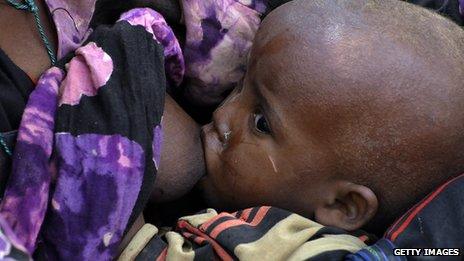Breast cancer: What is the risk?
- Published

Angelina Jolie underwent a preventive double mastectomy after doctors estimated she had an 87% chance of developing breast cancer. How was that figure calculated and how does it differ from other women's risk of getting the disease?
Jolie's chances of developing breast cancer were so high because she inherited a mutated BRCA 1 gene from her mother, Marcheline Bertrand, who died of ovarian cancer at the age of 56.
The BRCA1 is present in everyone but only mutates in one in 1,000 people. Anyone with the mutation has a 50-80% chance of developing breast cancer.
But Jolie's risk figure was calculated to be even higher because of other factors, including family history.
"There are various computer programmes where you can input genetic information, family history and other things and it will calculate a figure, which is why she's got this very precise sounding number," says Dr Kat Arney, a senior science manager at Cancer Research UK.
But what are the chances of getting breast cancer if you don't have a mutated gene?
It is already "the top cancer in women both in the developed and the developing world", according to the World Health Organization - and in many countries, it's becoming more common.
Incidence increased in the UK by 90% between 1971 and 2010. It is also on the rise in the developing world.
This is partly explained by the fact that people are living longer and cancer is generally a disease that affects people in later life.

In the UK, the chance of developing breast cancer before the age of 30 is roughly 0.05% (one in 2,000). It goes up to 2% (one in 50) before the age of 50 and 7.7% (one in 13) before the age of 70.
However, it is after the age of 70 that the risk is highest. A third of all incidences of breast cancer occur in women aged over 70.
Overall, a woman living in the UK has a 12% chance of getting breast cancer during her lifetime. It's the same in the US.
But increasing longevity isn't the only reason for the high incidence of breast cancer.
"There is an increase in rates in younger women and it's for a number of reasons. We know that women's lifestyles are changing and being overweight and drinking a lot of alcohol is linked to breast cancer risk," says Arney.
Changes in reproductive habits are also a factor. According to Cancer Research UK, the relative risk of developing breast cancer is estimated to increase by 3% for each year an adult woman delays becoming a mother.

Breastfeeding a child reduces a woman's risk of breast cancer
Women who breastfeed also reduce their risk. The longer a woman breastfeeds, the greater the protection. It's estimated that risk is reduced by 4% for every 12 months of breastfeeding.
This may explain why women in richer countries have a higher risk of breast cancer.
African women are four times less likely to get the disease because they have children at a younger age, have more of them and breastfeed them for longer.
On the other hand, recovery rates are higher in developed countries.
"Breast cancer survival rates [range] from 80% or over in North America, Sweden and Japan to around 60% in middle-income countries and below 40% in low-income countries," according the WHO.
But with the number of cases of breast cancer rising in the UK, and in many other countries, how many women are taking the dramatic decision that Angelina Jolie was faced with - to have a mastectomy?
The latest figures show that 18,000 operations were carried out in England in 2010/11. There are no official figures on how many of those were preventive but the figure is estimated to be between 5-10%.
You can follow the Magazine on Twitter, external and on Facebook, external